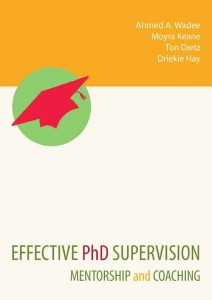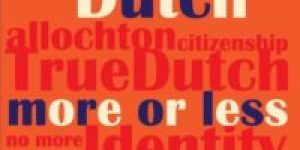Effective PhD Supervision – Appendices and Acknowledgments
1 CommentSanpad and its RCI programme
Anshu Padayachee
Having examined the statistical, demographic and institutional and equity characteristics of the cohort the outputs the research findings were as follows:
-The total cohort number under investigation stands at 191.
– All in all there have been 127 Ph.D.’s confirmed.
– This means that more than 1 in 2 cohorts graduated with a Ph.D. during the period under investigation.
– This also means that in a period of seven years, 16 Ph.D.’s were produced per year.
In terms of social categories the percentages of Ph.D. graduates 21 % were African females, 20%, African males, 17% Coloured females 1% Coloured males, 8% Indian females, 2% Indian males, 19% White females and 11.5% White males.
41% of the graduates were African, 19 % were coloured, 12.5% were Indian and 30, 5 % were Whites. In terms of gender 65% were females and 35% males.
In terms of years taken to attain the degree 53% achieved it in 3 years, 41% in 4 years and 6% in 5 years. In addition it became evident in the interviews that there were several traits evident in the feelings of respondents towards the Programme.
It was felt that it provided to them:
– A psychological boost
– A “changing of mind” experience
– A “Process” –driven experience
-Building collegial bridges
– The opening of possibilities
– Intellectual stimulation
– Real empowerment
The report that follows pinpoints the considerable achievements of an innovative, even path-breaking programme that is collaborative, transparent and pioneering in its scholastic and research endeavour.
The present second follow up report has confirmed the initial conclusion emanating from the initial report that the RCI has been a highly successful SANPAD Project that has been decisive in the effort of establishing a new cohort of researchers who utilised the programme to achieve academic and research excellence.
It is a programme rooted on comprehensive selection criteria and rigorous processes, and the evidence provided in the two reports signifies the programme’s importance nationally and regionally and as the new initiatives in a few SADC countries as well as Ethiopia show conclusively.
It is instrumental in the expansion of knowledge production and human capital.
It is very widely accepted that the present system does not produce Ph.D.’s in sufficient numbers and it has been known that only 0,01% of the country’s population has a Ph.D. as opposed to 0,1% of Indians who have this qualification .
– In term of social categories the percentages of Ph.D. graduates identified was as follows:
– African females 21% (22.5%)
– African males 20% (15.5%)
– Coloured females 17 % (17%)
– Coloured males 1% (1.4%)
– Indian females 8% (8.5%)
– Indian males 2% (4.2%)
– White females 19 %( 19.7%)
– White males 11.5% (11.3%)
It can be deduced then that:
– 41 % (38% in the first report) of the graduates were African.
– 19 % (18.4% in the first report) were coloured.
– 12.5% were Indian.
– 30, 5 % were Whites.
It can be gauged that in terms of equity the outputs were very encouraging as overall 69% of the graduates were Black in accordance with the equity laws of the country, while 31% were Whites. It can be deduced that innovative, well structured, designed and implemented initiatives such as the RCI can be considered significant in an upward spiral in regard to Ph.D. outputs, especially when stakeholders and role players in the system and processes associated with such efforts have demonstrated over the years a commitment and dedication in their efforts in shaping both the skills , capacity and mental strength that make high level researchers that could be in the short, medium and long term indispensable in the sustainable growth and development of the economy through innovation.
In terms of gender:
– 65% (as opposed to 67.7% in the first report) were females.
– 35% (as opposed to 32.3% in the first report) were males.
In terms of years taken to attain the degree:
– 67 (53%) as opposed to 56 (52.8%) in the first report achieved it in 3 years.
– 52 (41%) as opposed to 42(39.6%) in 4 years.
– 8 (or 6% as opposed to 7.6% representing the same number) achieved it in 5 years.
The Committee for Higher Education estimated in 2007 that the average period for a completion of a Ph.D. in South Africa fluctuates between 7-8 years on average. This indicates that the figures produced above can be described as very good.
– A psychological boost
There was a feeling that the overall programme provided a psychological boost to a number of cohorts in respect of their future scholastic endeavours.
As one of them said:
“Speaking to a lot of my colleagues at my university I had the feeling that doing a Ph.D. is a lonely exercise, it’s you, your supervisor and your research. I felt very differently when I joined the programme. I was not alone with my supervisor, I had a good number of people to talk, exchange ideas, share concerns, facing similar problems as researchers and human beings, and break the isolation. This gave me immense strength and belief in myself. I was not alone”.
– A “changing of mind” experience
Throughout the programme cohort with clear cut ideas about the topic, questions, methodologies and the like were convinced that changes in the process would be of value.
As one of the cohort elaborated:
“When you deal with a topic you are interested in and love in most cases you feel that your way to do is the best, sometimes the only way. The programme opened my eyes and mind to the real possibilities to the fact that on many occasions it is advisable to make changes, because your own ideas are rigid and will lead you to the wrong path. This means that I was given the opportunity by SANPAD to see my Ph.D. and my own beliefs in a very understanding and convincing way, by opening my eyes to realities that were outside me”.
– A “Process”-driven experience
There was a general belief that the process followed from Workshop 1 to the last was an eye opener in terms of the process followed throughout with the help and participation of everyone in the group.
As one student said:
“SANPAD was manna from heaven for me. I had registered for a Ph.D. and it was a time of challenge for the proposal to be prepared and accepted. The process followed in the workshops opened my eyes because I realised that it is all in our minds, but the ideas need to follow a process of shaping, planning, knowledge and application. Every workshop was a milestone in the process, testing your ideas, understanding, knowledge, innovation, application and all these things that relate to the proposal. Then there was the participation, the corrections, the debates, the comments This process made me believe in myself and two months later my proposal was accepted by my faculty higher degrees without any suggested changes”.
– Building collegial bridges
The building of collegial bridges amongst cohort was mentioned by all of them with a feeling of nostalgia.
This is captured adequately in the following response:
“I loved the mixing of my colleagues, the interaction and engagement with students from all over the country. The facilitators were outstanding but what really impressed me at a personal level is how I was treated by my colleagues both inside and outside the workshops. We shared, we laughed and we really cared for each other, and this was a deep feeling I got and it grew on me when I left the place. Then I realised that bonding, sharing and friendship are so important, especially when they are maintained as in our case. Besides the intellectual contribution, the human bonding was very important for all of us.
– The opening of possibilities
It became evident that for a good number of the cohort interviewed the opening of possibilities for success became evident, thus replacing lack of belief. This was expressed by a cohort as follows:
“Before joining SANPAD, working towards my PhD degree was something I saw as impossible, or near impossible. I worked on it in a variety of ways, in different stages, using a number of notebooks. After the first and the second workshop the possibilities became more visible, tangible. The possibilities widened throughout, I was now surer where I was going, my supervisor saw the difference in my drafts. My proposal writing became more coherent, until my proposal was accepted”.
– Intellectual stimulation
Besides the collegial feelings and togetherness, intellectual stimulation became a part of the process as one interviewee confessed:
“I have learned so much and really felt grateful and privileged that I have been given such an advantage in the process towards intellectual stimulation through important and insightful presentations, discussions and challenges. I learnt a and z of thinking, relating concepts with questions, relationships and even statistics. It helped me immensely as a student and a supervisor. This intellectual stimulation provided me with a great belief in myself. The experience was once in a life time”.
– Real empowerment
There was a common thread amongst all cohorts that a programme empowered them as academics, researchers and human beings.
As one of the interviewees said:
“The RCI has helped me, been empowered at all levels by providing for me not only with a thorough understanding of methodologies and way of thinking, but also all these relationships underlying the research process such as the conceptual frameworks, the proper formulation of research questions, the objectives , the timing and other details inherent in this exercise and the contingencies embodied in all these steps. The interaction with top researchers and academics in the top of their field and their whole attitude empowered me as a person and a researcher”.
Perhaps the most moving tribute to the programme is to be found in a Ph.D. thesis whose author graduated from a top South African University in 2009. The final part of his “Acknowledgements” reads as follows:
The research and financial support of SANPAD is acknowledged with gratitude. I gained enormous support in methodology through the dedicated South African and Dutch academics, especially Dr.A. Padayachee, the CEO.
I salute you all.
Anshu Padayachee
Acknowledgments
The contributions of various individuals and institutions throughout South Africa, who have shared their experiences and practices, and the students and supervisors and many individuals, who shared their thoughts and ideas and gave their input freely, are gratefully acknowledged.
In particular, SANPAD wishes to acknowledge the PhD candidates, their supervisors and the facilitators of the Research Capacity programme (RCI), all of whom provided valuable insights and contributions in reworking the first edition of this workbook. Furthermore, it is with sincere gratitude that we recognise the contributions of the following persons:
– The authors of this workbook, namely, Prof Ahmed Wadee, Dr Moyra Keane, Prof Driekie Hay and Prof Ton Dietz
Dr Anshu Padayachee who is responsible for curriculum development and who contributed to the Introduction (Chapter 1) by placing this workbook in perspective
– The Director General for Higher Education and Training, Ms Mary Metcalfe, for writing the foreword to this workbook
– The SANPAD secretariats in SA and the NL, and CERES for the administrative support provided for both this workbook and during workshops
– Harry Wells, Nelke van der Lans and Sabine Plantevin for their input and assistance
– Rozenberg Publishers for the production of the workbook
– The Netherlands Government, through the SANPAD programme in South Africa, for their financial support.
You May Also Like
Comments
One Response to “Effective PhD Supervision – Appendices and Acknowledgments”
Leave a Reply







November 13th, 2013 @ 11:32 am
U.S. Students: http://graduate-school.phds.org/education-index/online-business-degree is a comprehensive and informative resource that systematically sorts out the available business undergraduate and graduate programs available today in the U.S. I think this information is very valuable to students today who are not only dealing with the competitive nature of higher education, but also the rising costs of it.